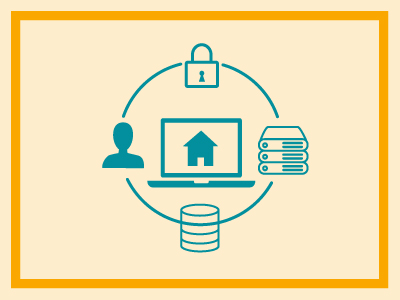The size of the mobile workforce is expected to surpass 94 million by 2024, representing an increase of 15 million workers since 2020. This growth has been spurred on by the COVID-19 pandemic, environmental concerns, rising fuel costs, and personal preferences. Employees with roles ranging from data entry clerks to C-suite executive decision-makers are working remotely at least part of the time.
Remote work provides many individual and organizational benefits. Unfortunately, it also complicates the efforts to protect a company’s IT environment and data assets. Supporting a mobile workforce combined with the ever-present threat posed by cybercriminals keeps security professionals up at night.
Effective Steps to Protect Data in Remote Workspaces
A methodical approach is necessary to address cybersecurity in remote work environments. The following steps will help an organization with a mobile workforce protect its valuable data resources.
Develop a comprehensive cybersecurity policy
The first step companies should take to protect data is to develop a comprehensive cybersecurity policy. An organization should document how its employees should handle sensitive data and keep it safe. Employees should be required to review the policy periodically and verify that they understand its details. The security policy should be updated regularly to reflect changes in the environment and emerging threats.
Provide employee training
Human error is responsible for a large percentage of data breaches. The incidence of human error can be minimized with security-focused employee training. The training should include a review of the company’s cybersecurity policy and details about the methods and processes it contains.
Employees should also be trained on recognizing phishing emails that attempt to lure them into compromising login credentials. Workers also need to learn the risks of using unsecured network connections, accessing company systems with personal devices, and using simple passwords. Proper employee training can reduce the probability of cybercriminals gaining access to a company’s network.
Use secure Internet connections
Remote workers have to always use secure Internet connections. Employees cannot be logging directly into the company network over the free WiFi at Starbucks. That distinguished-looking gentleman with a laptop may be a hacker looking for an unsuspecting victim.
All members of the mobile workforce should be required to use virtual private network (VPN) software at a minimum. The VPN will encrypt data transmission and protect login credentials that could be compromised over an open network connection. If possible, employees should use a wired Internet connection to access company systems.
Enforce zero trust network access (ZTNA)
Zero trust network access is an approach to cybersecurity that assumes every connection is malicious until it is proven to be legitimate. Nothing inside or outside the network is to be treated without verification and authentication. A zero trust mindset is appropriate in any computing environment but has enhanced utility when used to secure a remote workforce.
Zero trust requires every action to be authenticated and verified. It prevents users and devices from accessing sensitive information that should be protected. With ZTNA, compromising network security will not allow an intruder to exploit the complete infrastructure.
Implement a strong password policy
A company’s remote workforce should have to adhere to a strong password policy. Trivial passwords that are easily guessed expose systems and devices to brute-force cyberattacks. As painful as it may seem to use long and complex passwords, they offer a valuable method of protecting computing resources. Users should be made aware of the need for strong passwords when they review the company’s cybersecurity policy.
In addition to strong passwords, users should not share passwords or use the same words for multiple accounts. These general password protection measures are more important when used by a remote workforce where there is the potential for confusing work and personal applications.
Employ multi-factor authentication (MFA)
Strong passwords are not enough to fully protect a company’s valuable data. More robust methods are required to keep cybercriminals from compromising enterprise computing resources. Multi-factor authentication requires that users provide more than one method of verifying their identity when connecting to a system or application.
MFA is usually performed using three types of authentication factors.
- Something you know – this can include passwords, PINs, code words, or secret signals.
- Something you have – including smartphones, USB security keys, and token devices.
- Something you are – elements of the human body can be used for verifying identification through techniques like retina scans, fingerprints, and facial recognition.
Combining at least two of these factors makes it much harder for a hacker to impersonate a victim’s identity. Many banks and financial institutions use MFA for certain interactions, requiring users to enter PINs sent to their mobile devices to gain access to their accounts.
Securely back up data regularly
A cloud-based backup solution should be adopted for all remote users. Backing up enterprise data from a mobile workforce serves several important purposes.
- Backups protect against data loss caused by accidental deletion, lost or damaged mobile devices, and malware infection.
- Backups offer protection against ransomware attacks that may try to encrypt data resources and impact system availability.
- Backing up data to a central repository enables it to be shared by users in any location.
Institute end-to-end encryption
All data should be encrypted when at rest and in transit to protect it from unauthorized use. This will entail using compatible software that encrypts information without negatively affecting system performance. Encrypting communication channels reduces the risk of stolen credentials.
Conduct a Risk Assessment
A risk assessment carried out by a reliable and experienced third party can help identify weaknesses that affect a company’s ability to protect its data in remote work environments. Prescient Solutions offers a vulnerability and security assessment using the same processes a hacker would employ to defeat your defenses. They’ll find the gaps in your security before they result in a business-impacting data breach.
Prescient also offers managed security services that can be delivered onsite or remotely to ensure your valuable systems and data are protected. Engaging Prescient as your security partner is a great way to protect your computing environment.


